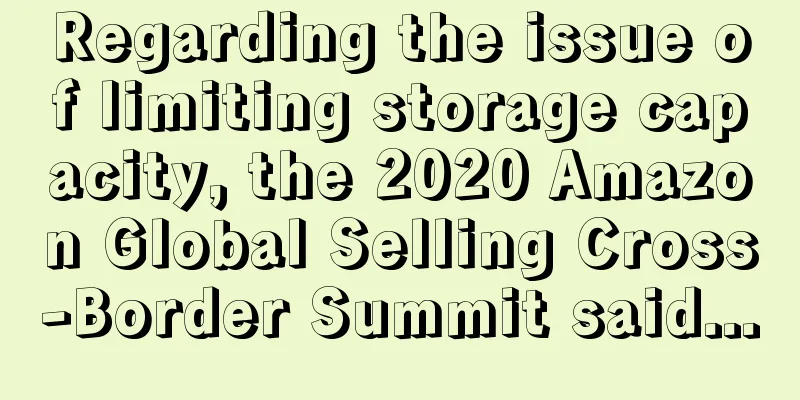Regarding the issue of limiting storage capacity, the 2020 Amazon Global Selling Cross-Border Summit said...

|
Recently, many sellers have faced the problem of out-of-stock. Although sellers are desperately raising prices, sales volume still cannot be reduced, and even the inventory is almost cleared out. After the out-of-stock situation, the ranking has also plummeted. ▲ Image source: seller communication group After the out-of-stock situation, Amazon should have actively restocked the products. However, Amazon has started to limit the maximum inventory capacity of sellers since last Saturday. It can be said that according to the current situation, Amazon will not be able to lift the inventory capacity restrictions in the short term. So will Amazon restore its pre-pandemic unlimited storage capacity in the future? In this regard, some sellers began to speculate↓↓↓ “ Everyone is waiting for Amazon to lift its inventory restrictions. This will definitely not happen in 2021, and it is very likely that it will never happen. Even if the restrictions are eventually lifted, new assessment indicators will most likely be introduced, and it will be difficult to return to the unlimited inventory capacity before the epidemic.” ▲ Screenshot from blogger @amz成都小米 The seller said: Amazon had already formulated rules in 2019, wanting sellers to provide high-quality products . However, the 2020 epidemic happened and the storage capacity was in short supply. Amazon could only provide priority storage capacity for high-turnover products. This storage capacity is basically the storage capacity for more than one month's sales. In addition, Amazon has previously stated that the warehouse limit inventory performance indicators will be updated in mid-December. Although Amazon stated in the announcement that it would leave more space for as many sellers' products as possible, seeing the current inventory capacity inevitably makes sellers more worried. ▲ Screenshot from Amazon announcement "What plans and changes does Amazon have regarding its future inventory capacity policies? Will it restore its pre-pandemic unlimited inventory capacity?" This has become the issue that sellers are most concerned about. As a cross-border e-commerce industry media, AMZ 123 attended the "Future, Prepared - 2020 Amazon Global Store Cross-border Summit" held on December 14 with the above questions. ▲ 2020 Amazon Global Selling Online Cross-border Summit Media Communication Meeting 1. Continue to support enterprises in their transformation to online business models and seize opportunities for cross-border e-commerce development; 2. Support sellers to expand global opportunities, develop multi-site businesses and reduce risks; 3. Support sellers to build international brands trusted by global consumers, corporate and institutional buyers, and build “brand power”; 4. Support sellers to continuously optimize product selection strategies and enhance “product power”. It can be seen that "product power" and "brand power" are still the key points that sellers need to pay attention to in future operations on Amazon. At the same time, sellers are also very concerned about the current logistics, storage capacity and other issues. Therefore, in the interview session of the meeting, we asked questions about the inventory issues that sellers are concerned about, hoping to get Amazon's policy disclosure on inventory capacity. : Many sellers have recently been facing a shortage of stock, but Amazon has limited the maximum inventory capacity of sellers since last Saturday, which is a huge challenge for sellers. Then some sellers have made predictions, believing that not only this year, but also in the future, the inventory capacity may be restricted. Even if the restrictions are finally lifted, new assessment indicators are likely to be introduced, and it will be difficult to restore the unlimited inventory capacity before the epidemic. Can you reveal some information about the policy on limiting inventory capacity? Peng Jiaqi, Vice President of Amazon China and Head of Amazon Global Selling Products in Asia Pacific: I would like to share first, in fact, in the United States, including the global market, why do we make so many adjustments? Because of the epidemic, many consumers have changed their behavior from offline shopping to online shopping, resulting in a surge in online shopping. For cross-border e-commerce companies and friends, it is a challenge, but also an opportunity. It is also because of this that we can see that in 2021, although China's exports as a whole have been greatly impacted, through cross-border e-commerce exports, we have seen counter-cyclical growth. Cross-border e-commerce has been growing by double digits for many consecutive years, so this is a big trend. Under this big trend, we believe that many consumers’ behaviors will not necessarily return to their original behaviors. If consumers have already shopped online, they are used to online shopping and enjoy the convenience, and they will continue to shop online. This will also continue to bring us many challenges and opportunities. The reason why Amazon has made a series of restrictions, such as storage capacity and warehouse restrictions, is to enable our operational capabilities and our warehouses to best serve the needs of local consumers, and to deliver daily necessities and urgently needed goods to local consumers more quickly. Under this premise, we will release a series of different policies. At the same time, in the process of releasing different policies, we will use better inventory indexes and indicators to help sellers improve their inventory health. We will also propose a variety of different warehousing methods in combination with more overseas warehouses. I think it is very important for sellers to maintain a healthy inventory, and it will be very important in the future. We need to work with sellers on the selection of products we just talked about, so that our inventory can serve the selection of high-demand products and make continuous efforts. We know that many sellers need help with inventory optimization. In this process, we also have many new tools, such as FBA, which can help sellers sell or clear some relatively slow-selling products in different forms as quickly as possible. This can help clear up their inventory capacity and put more high-demand products in, so there will also be a series of different solutions. I believe that next year and in the future, there will still be many consumers shopping online. Under such a big premise, we hope to work together with Chinese sellers to improve the health of our inventory and provide better services to local consumers. I would like to summarize the key points of the above answers here: 1. This year's cross-border e-commerce has both challenges and opportunities. Sellers first need to correctly recognize the challenges and opportunities and build confidence. 2. Amazon is also using inventory indexes and indicators to improve the health of sellers' inventory, and has proposed a variety of different warehousing methods in combination with more overseas warehouses. 3. Sellers need to maintain and improve the health of inventory, for example, by optimizing product selection strategies. Although the person in charge did not disclose when the storage capacity restrictions would be lifted, such an answer can give sellers a deeper understanding of storage capacity, so that they can better deal with inventory restrictions and better maintain inventory health. At this summit, we also learned that during the epidemic, Amazon has made active investments and efforts in warehouse capacity, operational capabilities and efficiency, inventory health, logistics operations and warehousing to help sellers actively prepare for challenges. 1. Storage capacity: More than 50 new operation centers have been added in the United States, Japan and India. Compared with the same period last year, the capacity for standard parts inventory has increased by 1 million cubic meters. 2. Operational capacity and efficiency: We have hired more than 175,000 employees worldwide to help us better improve warehouse operation capacity. At the same time, we also cooperate with overseas warehouse service providers to increase additional storage capacity, including providing FBA replenishment and other services. 3. Inventory health: Amazon has increased the transparency of the inventory health index, allowing sellers to understand how to optimize inventory health and work with sellers to use inventory capacity for products that consumers urgently need. Cooperating with self-delivery logistics companies can help sellers provide delivery methods other than FBA and more favorable delivery prices. 4. Logistics operations and warehousing optimization: On the one hand, Amazon continues to optimize integrated solutions. For example, Pan-EU is an integrated logistics solution for Europe. On the other hand, Amazon will further increase the capacity of the first leg and warehouse. Through Amazon's cross-border logistics, it has developed a variety of different first-leg transportation methods such as air transportation, sea transportation, and express ships. In fact, from a series of measures such as adding operation centers, hiring employees, and logistics solutions, we can see that Amazon has made a lot of efforts in logistics and warehousing operations this year, which has also alleviated the logistics and inventory operation difficulties of sellers during the epidemic. At the same time, we hope that sellers can respond quickly, make adjustments in flexible production chains and rapid replenishment, and work with Amazon to help overseas consumers purchase the products they need and urgently need more quickly. Finally, let's do a small survey. What specific measures have sellers taken to maintain the health of storage capacity? Feel free to leave a message in the comment area~
From December 18th to 19th, we will participate in the 2020 China (Yiwu) 7th Cross-border E-commerce Export Summit Forum and Cross-border E-commerce Export Supply Chain Product Selection Matchmaking Meeting. This conference will break through the ecological barriers of cross-border e-commerce platforms, cross-border source factories, sellers and service providers, and enable "good sources" to find "good sellers", "good sellers" to find "good platforms", "good platforms" to find "good factories", and "service providers" to find "good sellers". Here comes the point. I hope all sellers will be aware of the following information: Time: 2020-12-18 09:00 to 2020-12-19 17:00 Location: Exhibition Hall, 3rd Floor, Crowne Plaza Hotel, Yiwu, Jinhua, Zhejiang Organizer: WinShare Booth No.: E2-133 See you at booth E2-133 on December 18-19! Please long press the QR code below to sign up~ |
<<: Fined 35 million euros? A review of the things Amazon was fined for
Recommend
What are LINE ads? LINE ads review
LINE is an instant messaging software launched by ...
Collect all the bits and pieces about Amazon reviews now! The big boss is here
Let’s first talk about the environment of the Amaz...
Amazon US FBA policy update! Allowing more products to create shipments and enter the warehouse!
Amazon US FBA now allows more products to create s...
What is Similarweb? Similarweb Review
Similarweb is a very powerful market competition a...
What is Listing? Listing Review
Listing is to upload product information to the se...
The US dollar is on the road to breaking "7" and there is no turning back. Will all punitive tariffs be cancelled? !
Some time ago, when I had just finished writing ab...
What is Nordic Logistics? Nordic Logistics Review
Since its establishment, with the rapid developmen...
What is GS certification? GS certification evaluation
The GS, or "Geprüfte Sicherheit" (Safety...
Amazon bucks the trend and rises! Primeday starts reporting in advance
Buffett has only seen 5 U.S. stock market circuit...
Rumor or Amazon's big move? Will your account be frozen if you don't verify your payment information?
With the new CEO Jassy taking office, Amazon's...
What is Huifu Tianxia? Huifu Tianxia Review
Huifu.com was founded in June 2006 and listed on t...
Home Depot's Q3 revenue is $43.2 billion, and it raises its full-year earnings forecast
It is learned that recently, the US home furnishin...
Amazon's new rules on October 1! Fines for non-compliance? !
There are so many things that will affect us Amaz...
What is Merchantwords? Merchantwords Review
Merchantwords is a keyword tool for Amazon. It is ...









